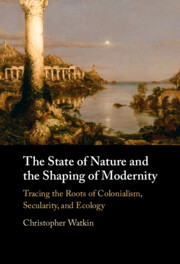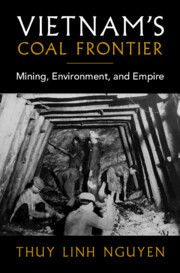Refine search
Actions for selected content:
1189 results

Irish Romanticism
- A Literary History
-
- Published online:
- 27 November 2025
- Print publication:
- 11 December 2025
Comprehensive perceptions at the interface between health and environment: Applications models with a Citizen Science Tool
-
- Journal:
- European Psychiatry / Accepted manuscript
- Published online by Cambridge University Press:
- 20 November 2025, pp. 1-41
-
- Article
-
- You have access
- Open access
- Export citation

The State of Nature and the Shaping of Modernity
- Tracing the Roots of Colonialism, Secularity, and Ecology
-
- Published online:
- 19 November 2025
- Print publication:
- 18 December 2025
Laypeople have difficulty processing efficiency when assessing environmental policies
-
- Journal:
- Behavioural Public Policy , First View
- Published online by Cambridge University Press:
- 18 November 2025, pp. 1-28
-
- Article
-
- You have access
- Open access
- HTML
- Export citation
Tariffs as Environmental Protection: Evidence from the Global South after the China Garbage Shock
-
- Journal:
- British Journal of Political Science / Volume 55 / 2025
- Published online by Cambridge University Press:
- 14 November 2025, e160
-
- Article
-
- You have access
- Open access
- HTML
- Export citation
6 - Ecological Footprints and Other Forms of Spatial Analysis
-
-
- Book:
- Explaining the History of American Foreign Relations
- Published online:
- 24 October 2025
- Print publication:
- 13 November 2025, pp 121-138
-
- Chapter
- Export citation
7 - Medicine, Science, and the Environment
-
-
- Book:
- Explaining the History of American Foreign Relations
- Published online:
- 24 October 2025
- Print publication:
- 13 November 2025, pp 139-160
-
- Chapter
- Export citation
A systematic review and meta-analysis of the impact of environmental disadvantage on youth delayed reward discounting
-
- Journal:
- Development and Psychopathology , First View
- Published online by Cambridge University Press:
- 12 November 2025, pp. 1-16
-
- Article
-
- You have access
- Open access
- HTML
- Export citation

Vietnam's Coal Frontier
- Mining, Environment, and Empire
-
- Published online:
- 25 October 2025
- Print publication:
- 13 November 2025
Iron mining waste as a sustainable material for producing bricks: microstructure, mechanical and thermal properties
-
- Journal:
- Clay Minerals / Volume 60 / Issue 3 / September 2025
- Published online by Cambridge University Press:
- 14 October 2025, pp. 273-284
-
- Article
- Export citation
Chapter 3 - Fossil Fuels and the Fiction of Extraction
- from Part I - Origins
-
-
- Book:
- Commodities and Literature
- Published online:
- 14 October 2025
- Print publication:
- 09 October 2025, pp 61-75
-
- Chapter
- Export citation
Locating and Analysing Environmental Education-Related Courses in Teacher Education Programmes in the Indian Context
-
- Journal:
- Australian Journal of Environmental Education , First View
- Published online by Cambridge University Press:
- 01 October 2025, pp. 1-14
-
- Article
-
- You have access
- Open access
- HTML
- Export citation
Excavating Alcatrazes, Santiago Island, Cape Verde: early colonial impacts on land, people and material culture – ERRATUM
-
- Article
-
- You have access
- Open access
- HTML
- Export citation
Chapter 10 - Science
- from Part II - Themes and Issues
-
-
- Book:
- The Cambridge Companion to Modernist Theatre
- Published online:
- 28 August 2025
- Print publication:
- 11 September 2025, pp 180-197
-
- Chapter
- Export citation
Impact of puberty timing, status and oestradiol on psychotic experiences in the context of exposomic and genomic vulnerability to schizophrenia in female adolescents: longitudinal ABCD study
-
- Journal:
- The British Journal of Psychiatry , FirstView
- Published online by Cambridge University Press:
- 03 September 2025, pp. 1-8
-
- Article
-
- You have access
- Open access
- HTML
- Export citation
A matter of life and breath for Ella – the formally acknowledged threat of air pollution as a breach of the right to life
-
- Journal:
- Legal Studies / Volume 45 / Issue 3 / September 2025
- Published online by Cambridge University Press:
- 26 September 2025, pp. 394-413
- Print publication:
- September 2025
-
- Article
-
- You have access
- Open access
- HTML
- Export citation
Islamic Normative Legal Theory: Framework and Applications
-
- Journal:
- Journal of Law and Religion , First View
- Published online by Cambridge University Press:
- 27 August 2025, pp. 1-31
-
- Article
-
- You have access
- Open access
- HTML
- Export citation
Mental health and the environment – evolutionary perspectives
-
- Journal:
- Irish Journal of Psychological Medicine , First View
- Published online by Cambridge University Press:
- 22 August 2025, pp. 1-6
-
- Article
- Export citation
13 - Joyce and Nature
-
-
- Book:
- The Cambridge Companion to James Joyce
- Published online:
- 14 August 2025
- Print publication:
- 21 August 2025, pp 216-231
-
- Chapter
- Export citation
Introduction to volume III
-
-
- Book:
- The Cambridge History of War
- Published online:
- 18 July 2025
- Print publication:
- 14 August 2025, pp 1-52
-
- Chapter
- Export citation
